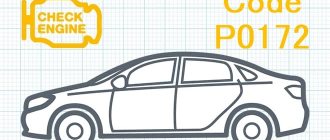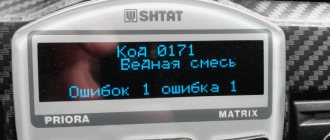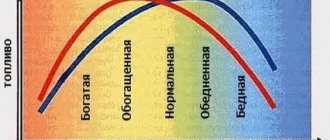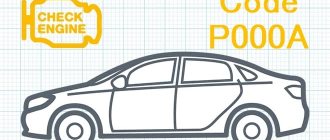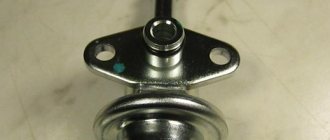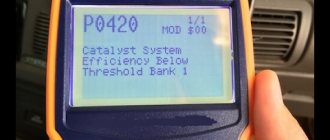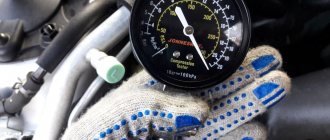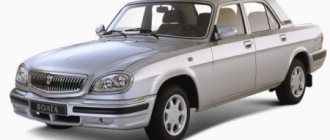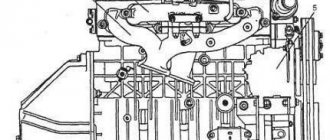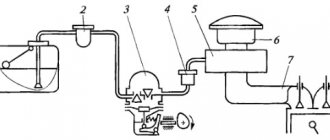Technical description and interpretation of error P0171
This diagnostic trouble code (DTC) is a generic powertrain code. Trouble code P0171 is considered a common code because it applies to all makes and models of vehicles. Although the specific repair steps may vary slightly depending on the model.
To operate correctly, the engine must add the right amount of fuel to the amount of incoming air. The correct air-fuel ratio is essential for optimal power and fuel efficiency.
The engine control unit (ECU) uses a number of sensors to determine the amount of fuel that needs to be added. Most often, the ratio of air and fuel in the mixture is determined based on the readings of oxygen sensors by calculating the amount of oxygen and carbon monoxide in the exhaust gases.
The most optimal ratio of air and fuel in the mixture supplied to the engine cylinders is 14.7:1. It is this ratio that is necessary to achieve maximum engine power and optimal fuel consumption.
During normal operation, the ECU monitors the balance between rich and lean mixture. Simultaneously monitoring short-term and long-term fuel balance (STFT and LTFT). Typically the fuel adjustment is 3% of the ideal value. This depends on the current air temperature, coolant and load.
Engine problems such as high fuel pressure, a distorted MAF signal, or a faulty fuel injector can increase fuel consumption. Due to these problems, incorrect airflow data is received, which will result in corrupted data.
The ECU will try to compensate for the imbalance in the fuel mixture. If the control module fails to maintain the 14.7:1 ratio, it will trigger DTC P0171 - Fuel Mixture Too Lean (Bank 1).
Symptoms of malfunction
The main driver symptom of P0171 is the MIL (Malfunction Indicator Light). It is also called Check engine or simply “check light”.
They can also appear as:
- The “Check engine” warning light on the control panel will light up (the code will be stored in the ECM memory as a malfunction).
- Floating speed, the car engine may operate unstably.
- Decrease in engine power.
- The engine stalls or has trouble starting.
- Increased fuel consumption.
- Possible misfires in the engine cylinders.
The severity of the P0171 code is higher than average, so it is recommended to fix the problem as soon as possible. Most likely, with this problem, you will be able to continue your trip, but fuel consumption will increase. And due to poor fuel combustion, problems with the catalyst are possible in the future.
Causes of a “lean” mixture
Having dealt with the risks that may arise when error P0171 appears, you need to move on to the causes of the problem.
As mentioned above, fuel assembly depletion can occur for two reasons:
- Too little fuel enters the cylinders;
- Too much air is supplied;
Lack of fuel and/or excess air can lead to different problems. In the case of air, you should immediately check the mass air flow sensor, as its failures will lead to incorrect readings. The sensor may be either faulty or dirty.
More excess air can enter the intake through the EGR valve. If the valve does not close tightly enough, exhaust gases continually fall into the intake. Also, other causes of air leaks into the intake should not be ruled out.
For insufficient fuel, the fuel pump is checked first. If the pump does not produce the required pressure, the reason is obvious. The next element is the fuel injectors. Their malfunction or contamination also causes insufficient fuel supply in a certain unit of time.
You should also pay attention to the fuel filter. It also happens that the pump and injectors are in order, but fuel is not supplied in the required volume. Fuel may also partially flow out in the area of the pressure regulator without entering the combustion chamber.
As you can see, there are really many reasons. It turns out that to eliminate the causes of error P0171, a comprehensive diagnosis of the ECM, as well as the engine power system, is necessary.
Reasons for the error
Code P0171 may mean that one or more of the following problems have occurred:
- The mass air flow (MAF) sensor may be dirty or damaged.
- The air filter is dirty or contains oil.
- Possible vacuum leak.
- Fuel pressure problem.
- Damage to the fuel injector.
- Worn spark plugs.
- The fuel pump check valve may have failed.
- The PCV valve is leaking or has failed.
- The EGR valve may be stuck.
- Faulty oxygen sensor (Bank 1, Sensor 1)
- EVAP valve leaking.
How to Troubleshoot or Reset Trouble Code P0171
Some suggested steps to troubleshoot and fix error code P0171:
- Inspect all vacuum and PCV hoses, replace if necessary
- Clean the mass air flow sensor. It's best to remove it and clean it with electronics cleaner or WD. Be careful not to damage the MAF sensor, make sure it's dry before reinstalling.
- Inspect the fuel lines for cracks, leaks, or pinches.
- Check the fuel rail pressure.
- Check the fuel injectors; they may be dirty. Use fuel injector cleaner or have them professionally cleaned/replaced.
- Make sure there is no exhaust leak before the first oxygen sensor.
Lean mixture at idle and under load: carburetor, injector
To determine the possible causes of a lean mixture, let's start with a simpler carburetor internal combustion engine. On such motors, the problem is most often localized in the power system. The list of common faults includes:
- the carburetor prepares a mixture whose composition does not correspond to the operating mode of the engine;
- there is an insufficient supply of fuel from the fuel tank; there is a low fuel level in the carburetor float chamber;
- fuel does not reach the carburetor in full, that is, a leak has occurred;
It turns out that incorrect settings of the dosing system (carburetor) can lead to a lean combustible mixture. For example, if the fuel level in the float chamber is set to low. Also, one should not exclude the possibility of clogging of fuel jets, individual violations during their adjustment, etc.
It is also possible that the shut-off needle in the carburetor float chamber is in the closed position. At the same time, it is necessary to check the fuel lines and fuel filters, the tightness of the gas tank, the operation of the air valve in the tank cap, and the fuel pump.
As for the air supply, third-party suction is most often noted in those places where the carburetor is connected to the intake manifold, as well as in the area where the intake manifold is connected to the internal combustion engine, etc. Excess air can be sucked in as a result of loose fasteners, destruction of sealing gaskets, cracking of structural elements and other defects.
Lean mixture on the injector: “check”, lean mixture
The fuel injection system is more complex than a carburetor, as it includes a large number of electronic sensors. Failure of individual devices or depletion of the mixture for other reasons leads to the fact that in some cases a “check” lights up on the instrument panel.
For example, air may be sucked in at the place where the idle speed sensor is installed. One of the simplest reasons may be a cracked or damaged rubber gasket ring, which seals and seals the connection.
Let us add that problems with mixture formation and leanness on many engines are detected by the system as error p0171, lean mixture. In this case, it is necessary to conduct computer diagnostics of the engine. If a “lean mixture” engine error occurs, then you should check the intake system, power system, ECM, as well as individual elements in the exhaust system.
In the list of the most common problems, experts highlight:
- contamination of injection nozzles;
- intake air leak;
- oxygen sensor (lambda probe);
- mass air flow sensor (MAF);
Constant malfunctions of the internal combustion engine due to mixture formation are usually caused by a dirty air flow sensor. This sensor simply loses the ability to correctly calculate the amount of air consumed. Also note a possible vacuum leak.
Another cause could be the EGR valve. The specified valve of the exhaust gas recirculation system becomes very dirty during operation and ceases to close tightly, as a result of which excess air is sucked into the intake through the slightly open valve. Increased air flow through the EGR valve can also be caused by a failure of the pressure difference sensor in the recirculation system.
As for the power system, the mixture becomes leaner:
- decreased fuel pump performance;
- contamination of fuel filters and fuel supply lines;
- decreased performance and contamination of injection nozzles;
- leaks through the fuel pressure regulator in the fuel rail;
In the exhaust system, special attention should also be paid to the lambda probe and catalyst. Quite often, it is the lambda that shows a lean mixture, when scanning, the error “lean catalyst mixture” is recorded, the diagnostics determines an incorrectly functioning oxygen sensor, a lean mixture is formed due to malfunctions of the oxygen sensor and a failed/burnt-out catalytic converter.
Checking and eliminating causes
General diagnostics begins with the ECM sensors. Typically, the P0171 code occurs due to a malfunction of the MAF sensor (mass air flow sensor). The fact is that the specified sensor ceases to respond in a timely manner to changes that relate to air flow. The cause is usually an accumulation of contaminants.
Contamination of the MAF sensor can occur due to the ingress of fuel vapors that penetrate through the intake and throttle assembly at times when the engine is not running. As a result, a layer of paraffin forms on the sensor, as well as on its wiring, which causes the sensor to send an incorrect signal to the ECU about the lack of air to prepare the mixture.
In this case, the control unit automatically reduces the fuel supply so that the amount of air increases. The result is a lean mixture at different operating modes of the power plant. After this, error P0171 occurs; in parallel, error P0100 or P0102 can be detected. Such codes usually indicate problems and malfunctions in the mass air flow sensor.
To eliminate the causes, the sensor must be removed, after which it is cleaned. You can use carburetor cleaner as a cleaner. The device must be cleaned carefully so as not to damage the sensitive element. If cleaning does not help, then the sensor needs to be replaced.
If the mass air flow sensor is in working condition, then further checking is to determine possible depressurization and air leaks. Defects may occur in the inlet pipe area, in the throttle body area.
- It is necessary to separately check all vacuum hose connections, intake manifold mounting location, throttle body gasket, intake manifold gaskets, etc.
- Also, cracking or other damage to the crankcase ventilation system pipes, fuel vapor recovery system hoses, and plugs on the intake manifold is not allowed.
- The exhaust system must be completely sealed (without corrugations, etc.), since defects near the installation site of the oxygen sensor will also lead to mixture formation failures.
As for the EGR system differential pressure sensor, if present, this sensor can also cause the P0171 code to appear if it fails or malfunctions. The specified sensor is located on the engine, connected to the main pipe for supplying exhaust gases to the USR using two separate pipes. The sensor controls the exhaust recirculation valve.
Contamination of the differential pressure sensor affects its sensitivity, causing the sensor to signal that not enough exhaust gas is entering the system, thereby forcing the EGR valve to open for a long time. This discovery leads to more air in the mixture and depletion occurs.
Now let's move on to checking the fuel system, since reducing the volume of fuel supplied in some cases does not allow the mixture to be enriched, leaving it lean. Fuel supply diagnostics involves the following steps:
- First of all, you should make sure that the fuel filters allow the fuel to flow in the proper volume.
- Then you will need to measure the fuel pressure in the fuel rail, and also make sure that the pressure regulator is working.
- At the same time, you may need to check the fuel pump and its performance.
- Another operation will be diagnosing the injectors (preferably on a bench), as well as cleaning them if necessary.
Having a professional car scanner or a compact device that connects to the OBD II diagnostic connector allows you to evaluate a number of parameters without disassembling the engine and removing equipment. If error P0171 appears with some frequency, then the cause may be an unreliable connection or damaged electrical contacts. In this case, the wiring of the sensors, wiring harnesses to the controller, and ground are checked.
Diagnosis and problem solving
A dirty MAF sensor can skew air intake measurements and therefore skew fuel injection calculations. Next, check the fuel pressure to make sure it is in the correct range. Excessive pressure, due to a faulty pressure regulator or a compressed line tube, will cause more fuel to be injected than the ECU expected.
Check that the ECT and IAT (inlet air temperature) readings are correct. The ECU can pick up blocked sensors, so it's good to check that the ECT and IAT readings are within the normal range.
For example, if the engine is running for half an hour on a hot day, the ECT should show a temperature of about 80°C. If it still reads 0°C, the ECU will richen the air/fuel mixture to compensate, resulting in a rich condition.
Reduced fuel pressure
With the engine running, record the fuel pressure, and then stop the engine. Fuel pressure may drop slightly but should remain stable for at least 10 or 15 minutes.
If fuel pressure continues to drop, you may have a leaking fuel injector, which will result in a rich and possibly non-ignitable condition.
Valve blocking
A faulty valve in the cylinder head dumps unburned fuel into the exhaust gas stream. Check and correct this problem before attempting to correct a rich air/fuel mixture error.
Pay attention to other trouble codes that may be present at the same time as P0171. For example, for VVT (variable valve timing) or ignition system.
Traffic fumes
Check the exhaust system for leaks, especially in front of the first O₂ sensor. Damage can be mechanical, in the form of cracks, or caused by corrosion.
The entry of atmospheric air before this sensor can distort the oxygen content measurements. At the same time, the ECU will try to compensate the mixture and add fuel.
So, what can you do yourself if you discover the P0171 error?
- Measure fuel pressure - pressure gauges are inexpensive, you can find a suitable one from friends. The measurement is carried out both with the engine turned off and with it running. If even with the engine off, the pressure is below normal (for your car, find the exact value on the Internet - usually from 3 to 4.5 bar), then the fuel pressure regulator is most likely to blame: a “tired” fuel pump is usually enough to produce the required pressure in the absence of fuel consumption. But its drop while the engine is running is more like a pump malfunction or a clogged filter.
- Was there any floating idle speed before? They will leak air into the intake even before the mixture begins to become too lean.
- Check the air temperature sensor using the method described above.
- It is difficult to assess the condition of the injectors “on the knee” - here it is better to contact a service center. By the way, it will be cheaper to bring them already removed and pay only for the work of the stand.
On which cars is this problem most common?
The problem with code P0171 can occur on different machines, but there are always statistics on which brands this error occurs more often. Here is a list of some of them:
- Audi (Audi a3, Audi a4, Audi a6, Audi q5)
- BMW (BMW X3, BMW X5, E39, E46, E53, E60, F10)
- Cadillac (Cadillac SRX)
- Chery (Chery Amulet)
- Chevrolet (Chevrolet Aveo, Camaro, Captiva, Cobalt, Cruz, Lacetti, Silverado, Spark, Trailblazer, Epica)
- Chrysler (Chrysler Voyager, PT Cruiser, Sebring)
- Citroen (Citroen C4)
- Daewoo (Daewoo Gentra, Lanos, Matiz, Nexia)
- Dodge (Dodge Caravan, Ram, Stratus)
- Fiat (Fiat Albea)
- Ford (Ford Galaxy, Kuga, Maverick, Mondeo, Taurus, Focus, Fusion, Expedition, Explorer, Escape, F-150)
- Honda (Honda Accord, Pilot, SRV, Fit, Civic)
- Hover
- Hummer H3
- Hyundai (Hyundai Getz, Santa Fe, Sonata, Tucson, Elantra)
- Infiniti (Infiniti fx35)
- Isuzu (Isuzu Rodeo)
- Jaguar
- Jeep (Jeep Grand Cherokee)
- Kia (Kia Carnival, Rio, Sid, Sorento, Spectra, Sportage, Cerato)
- Land Rover (Land Rover Range Rover, Freelander)
- Lexus (Lexus gx470, ls430, lx470, rx300, rx330, rx350)
- Lifan (Lifan x60)
- Mazda (Mazda 3, Mazda 6, Mazda cx5, Mazda cx7, Demio, Premasi, Tribute, Surname, MPV)
- Mercedes (Mercedes w203, w211)
- Mitsubishi (Mitsubishi Outlander, Galant, Delica, Lancer, Montero, Pajero)
- Nissan (Nissan Avenir, Hell, Almera, Bluebird Silphy, Vingroad, Beetle, Qashqai, Cube, Maxima, March, Micra, Murano, Note, Primera, Sunny, Serena, Teana, Tiida, X-Trail)
- Opel (Opel Antara, Astra, Vectra, Zafira, Insignia, Corsa, Meriva, Mokka)
- Peugeot (Peugeot 207, 307, 308, 408, Partner)
- Pontiac (Pontiac Vibe, Montana)
- Ravon (Ravon P4)
- Rover
- Saab
- Seat
- Skoda (Skoda Yeti, Octavia, Superb, Fabia)
- Ssangyong (Sangyong Kyron)
- Subaru (Subaru Outback, Impreza, Legacy, Tribeca, Forester)
- Suzuki (Suzuki Vitara, Grand Vitara, Ignis, Liana, Swift, sx4)
- Toyota (Toyota Avensis, Auris, Vitz, Vish, Ipsum, Camry, Corolla, Land Cruiser, Matrix, Passo, Platz, Prado, Prius, Rav4, Celica, Sienna, Tundra, Fielder, Funcargo, Highlander, Estima, Yaris)
- Volkswagen (Volkswagen Bora, Golf, Jetta, Caddy, Passat, Polo Sedan, Touareg, Tiguan)
- Volvo (Volvo s40, s60, s80, xc90)
- VAZ 2107, 2109, 21099, 2110, 2112, 2114, 2115
- Volga Cyber
- Gazelle
- Lada Vesta, Granta, Kalina, Largus, Niva, Priora
- Tagaz Tager
- UAZ Bukhanka, Patriot, 409
With fault code P0171, you can sometimes encounter other errors. The most common ones are: P0100, P0106, P0130, P0131, P0132, P0134, P0137, P0172, P0174, P0175, P0300, P0302, P0303, P0327, P0420, P0422, P0441, P1101, P1130, P201 5, P2187, P2195, C1201 , U1001.
